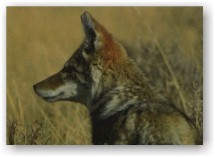Coexisting with Coyotes and Foxes

Canids, like coyotes and foxes, are versatile, intelligent and adaptable to most habitats. Over the last 100 years, coyotes and foxes have expanded their range and can now be found living across the country, even in American's most densely human-populated areas, and Milwaukee is no exception. Coyotes and foxes typically see humans as predators, and while the vast majority of their activity happens after dark when human activity is at its lowest, daytime activity is not uncommon. Negative interactions wit canids are often the result of habituation, or the process by wich coyotes and foxes lose this innate fear of humans due to the abundance of food and lack of negative interactions with humans. Maintaining a healthy relationship dynamic by minimizing the things we do to attract canids in conjunction with hazing techniques provides the best context for positive interactions with these resourceful creatures.
Keeping Coyotes and Foxes at a Distance
Coyotes and foxes thrive in cities where habitat resources (food, water, shelter) are abundant. Take the following steps to prevent them from being attracted to your home:
- Secure garbage cans by fastening lids with rope or bungee cords.
- Dispose of especially attractive food wastes such as meat, cheese and eggs by adding a small amount of ammonia to the bag.
- When composting, use enclosed bins rather than exposed piles. Avoid adding dog or cat waste, meat, milk or eggs to compost.
- If you have fruit trees, pick the ripe fruit and keep fallen fruit off the ground.
- Motion sensing lights or sprinklers may deter themfrom your yard. A motion sensing sprinkler, the "Scarecrow," is available online and in stores.
- Clear bushes and weeds away from your home. Dense vegetation provides attractive habitat for animals on whom coyotes and foxes prey.
- Maintain a clean outdoor cooking space to minimize attractants. Grease drip trays on grills will directly attract coyotes and foxes, as well as prey species.
Keeping Companion Animals Safe
Cats and small dogs may be seen as prey to a coyote, while larger dogs could be injured in a confrontation. To avoid these situations consider the following:
 Fence your yard. The fence must be at least six feet tall with the bottom extending at least six inches below the ground. Fences can be made more effective by installing a rolling bar across the top edge.
Fence your yard. The fence must be at least six feet tall with the bottom extending at least six inches below the ground. Fences can be made more effective by installing a rolling bar across the top edge.- Keep companion animals in at night. Coyotes are primarily nocturnal.
- Keep cats indoors where they are also safe from cars, other animals and from getting lost.
- Don't leave pet food outside.
- Spay or neuter your dogs. Coyotes are attracted to and can mate with unsterilized domestic dogs.
Trapping and relocation of coyotes and foxes is not recommended except as a last resort. Disruption of family packs can cause orphaned juveniles to seek easy prey, such as small dogs and cats, and other coyotes or foxes may move into the vacated area.
Coyote and Fox Encounters
 Coyotes and foxes are usually wary of humans and will avoid people whenever possible. Aggressive behavior toward people is not normal and is most often a result of habituation due to feeding by humans. If you encounter a coyote or fox, remember the following:
Coyotes and foxes are usually wary of humans and will avoid people whenever possible. Aggressive behavior toward people is not normal and is most often a result of habituation due to feeding by humans. If you encounter a coyote or fox, remember the following:
- Never feed or attempt to "tame" them.
- Do not turn your back or run.
- Attempt to leave the area calmly.
- If followed, make loud noises and make yourself look big. If this fails, throw rocks or sticks in the direction of the animal, being careful not to hit them.
Coyotes and foxes are not considered a disease threat. Outbreaks of rabies in wild canids are rare and not commonly implicated in the transmission of the disease to humans or companion animals.
Hazing
When implemented on a large scale, hazing can be one of the most effective ways to manage coyote and fox encounters in urban areas. The goal of hazing is to reverse the effects of habituation by associating humans with fear. If you see a coyote or fox, perform a hazing technique to begin building this association.
Hazing techniques generally fall into four categories:
- Human behavior - yelling, waving arms, and clapping to scare the animal
- Noisemakers - whistles, air horns, pots and pans, and "shaker" cans (pennies or stones in a soda can)
- Projectiles - sticks, balls, small rocks (note: projectiles should be thrown in the direction of the animal, not intending to harm it.)
- Other - sprinklers, spraying water at the animal with a hose
Continue hazing the animal until it leaves the area, as stopping prior to this point will render that technique ineffective.
Modified and reprinted with permission of the Animal Protection Institute

.png)

